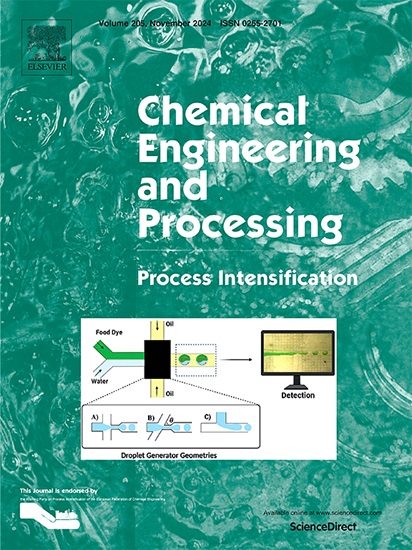Impact of lipophilic particles on oil-water separation efficiency in hydrocyclones
IF 3.8
3区 工程技术
Q3 ENERGY & FUELS
Chemical Engineering and Processing - Process Intensification
Pub Date : 2025-04-21
DOI:10.1016/j.cep.2025.110327
引用次数: 0
Abstract
Currently, oilfields have generally entered the high water content extraction period. The ASP (alkali-surfactant-polymer) flooding technology is widely used; however, the presence of polymer in the extracted fluid makes subsequent processing difficult, and it is challenging to achieve efficient oil-water separation using existing hydrocyclone separation technology alone. Therefore, in this study, lipophilic particles were added to the oil-water mixture to be separated, in order to adsorb and transport oil droplets, thereby improving oil-water separation efficiency. An experimental research program was proposed to treat an oil-water mixture using activated carbon as an adsorbent. The effects of parameters such as particle dosage, oil concentration in the mixture, and adsorption time on the adsorption effectiveness of activated carbon were investigated. Comparative analyses were conducted on particle transport trajectories and separation performance between conventional hydrocyclone and lipophilic particle-coupled hydrocyclone. The results show that the addition of lipophilic particles can effectively adsorb and transport oil droplets, significantly improving the oil-water separation efficiency, with the separation efficiency reaching up to 99.97 %.
亲脂颗粒对水力旋流器油水分离效率的影响
目前,油田普遍进入高含水采出期。ASP(碱-表面活性剂-聚合物)驱油技术应用广泛;然而,萃取液中聚合物的存在给后续处理带来了困难,仅利用现有的水力旋流器分离技术难以实现高效的油水分离。因此,本研究在待分离油水混合物中加入亲脂性颗粒,以吸附和输送油滴,从而提高油水分离效率。提出了一种以活性炭为吸附剂处理油水混合物的实验研究方案。考察了颗粒投加量、混合油浓度、吸附时间等参数对活性炭吸附效果的影响。对常规旋流器和亲脂颗粒耦合旋流器的颗粒输运轨迹和分离性能进行了对比分析。结果表明,亲脂颗粒的加入能有效吸附和输送油滴,显著提高油水分离效率,分离效率可达99.97%。
本文章由计算机程序翻译,如有差异,请以英文原文为准。
求助全文
约1分钟内获得全文
求助全文
来源期刊
CiteScore
7.80
自引率
9.30%
发文量
408
审稿时长
49 days
期刊介绍:
Chemical Engineering and Processing: Process Intensification is intended for practicing researchers in industry and academia, working in the field of Process Engineering and related to the subject of Process Intensification.Articles published in the Journal demonstrate how novel discoveries, developments and theories in the field of Process Engineering and in particular Process Intensification may be used for analysis and design of innovative equipment and processing methods with substantially improved sustainability, efficiency and environmental performance.

 求助内容:
求助内容: 应助结果提醒方式:
应助结果提醒方式:


